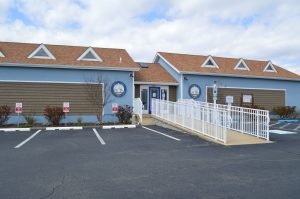
FENWICK ISLAND – With inundation maps now complete, officials in Fenwick Island are seeking recommendations to address future flooding events.
On Tuesday, representatives from AECOM came before the Fenwick Island Infrastructure Committee to provide an update on a town-wide resiliency study. With grant funding from the Delaware Department of Natural Resources and Environmental Control (DNREC), the company has been hired to complete GIS mapping of the town and develop short- and long-term solutions to sea level rise and flooding.
“You will have significant impacts in about 50 years from now,” said Kyle Gulbronson, project manager. “So we’re at the point now we know how bad things will be so we can start planning for solutions, to figure out how best to mitigate the flood damage.”
In his presentation this week, Gulbronson presented the committee with maps projecting water inundation over a period of 50 or so years.
AECOM officials noted the maps show 12% of bayside roads being inundated by 2060 and 33% of bayside roads being inundated by 2070.
“In 2030, you really don’t have many issues. The flood levels aren’t terribly more involved than they are currently,” Gulbronson said. “But as you move on through the years, there are additional areas that are inundated through the high tide cycle.”
Gulbronson said the maps projected bayside properties – particularly in the areas of North Schulz Road, South Schulz Road and Dagsboro Street – would see the most inundation in the coming decades.
“You’ll see in 2070 you start seeing large areas of the bayside starting to be impacted on a daily basis. Some of the areas are under two feet of water during the high tide cycle,” he said. “You get to 2080, and you have significant impacts on the bayside, anywhere from a foot to two-and-a-half feet of flooding per day.”
Gulbronson noted, however, that the maps produced for the resiliency study would allow town officials to begin making changes that would address sea level rise and flooding. He said engineers would soon begin looking at the town and making recommendations to mitigate flood damage.
“We’re at the point where we’ve started to look at individual streets and what should be priority street segments for flood mitigation …,” he said. “The maps will allow us to focus on the areas we need to start quickly.”
Councilman Richard Benn, committee chair, noted that once recommendations are made, the town could seek grant funding for resiliency projects.
“We have ARPA funds, and there are a lot of stormwater grants available,” he said. “So as soon as we get this, we can start applying for those immediately for the needs we know the town is going to have and start getting those projects underway.”
Committee member Amy Coombs said the town would also need to work with the community in developing solutions.
“This is going to take a lot of work, working with the community and DNREC and individual properties,” she said.
When asked when AECOM would have recommendations for the town, Gulbronson said it would likely be the end of the year.
“It should be fairly quickly,” he replied. “We have to have this project finished by June, so we’re looking at probably toward the end of this year.”
Committee member Jay Ryan questioned if the flood maps accounted for storm flooding, and not just tidal flooding.
“Are you taking this into consideration when you are coming up with solutions?” he asked.
Gulbronson said it did.
“They will be built into the solutions,” he replied.
Mayor Natalie Magdeburger, chair of the town’s charter and ordinance committee, noted that the recommendations would also be used to develop ordinance changes. Officials noted that the town could look into raising bulkhead heights.
“We need to make plans now. We are only seeing the beginnings …,” she said. “It’s scary to hear it, but there’s nothing like good planning to get us where we need to be.”
Last December, the town selected AECOM to complete a resiliency study funded by DNREC. The project, however, was brought to a standstill in recent months as officials awaited contract approval between the state agency and the engineering company.
AECOM has also been selected by the Delaware Department of Transportation to complete a resiliency study of Route 1. The goal of the study, the agency reports, is to examine the impacts of climate change and sea-level rise on transportation infrastructure and to incorporate resiliency measures in the planning, design, construction and maintenance of projects.
“At the same time, we’re also doing a resiliency study for Route 1,” Gulbronson told committee members this week. “So some of the mitigation solutions that come out of that project will help [this project] as well.”

